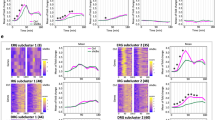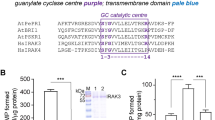Abstract
Activation of IκB kinase (IKK) is the key step in stimulation of the transcription factor NF-κB, which regulates many genes in the inflammatory response pathway. The molecular mechanism that underlies IKK activation in response to tumor necrosis factor (TNF) is still unknown. Using mitogen-activated protein kinase kinase kinase 3 (MEKK3)-deficient fibroblast cells, we found that MEKK3 plays a critical role in TNF-induced NF-κB activation. We have shown that MEKK3 is required for IKK activation and functions downstream of receptor-interacting protein (RIP) and TNF receptor– associated factor 2. We have also shown that MEKK3 interacts with RIP and directly phosphorylates IKK. The kinase activity of MEKK3 is pivotal to its function and, therefore, MEKK3 links RIP and IKK in TNF-induced NF-κB activation.
This is a preview of subscription content, access via your institution
Access options
Subscribe to this journal
Receive 12 print issues and online access
$209.00 per year
only $17.42 per issue
Buy this article
- Purchase on Springer Link
- Instant access to full article PDF
Prices may be subject to local taxes which are calculated during checkout




Similar content being viewed by others
References
Baeuerle, P. A. & Baltimore, D. NF-κB: ten years after. Cell 87, 13–20 (1996).
Baldwin, A. S. Jr The NF-κB and IκB proteins: new discoveries and insights. Annu. Rev. Immunol. 14, 649–683 (1996).
Siebenlist, U., Franzoso, G. & Brown, K. Structure, regulation and function of NF-κB. Annu. Rev. Cell Biol. 10, 405–455 (1994).
Ghosh, S., May, M. J. & Kopp, E. B. NF-κB and Rel proteins: evolutionarily conserved mediators of immune responses. Annu. Rev. Immunol. 16, 225–260 (1998).
Israel, A. The IKK complex: an integrator of all signals that activate NF-κB? Trends Cell Biol. 10, 129–133 (2000).
Karin, M. & Ben-Neriah, Y. Phosphorylation meets ubiquitination: the control of NF-κB activity. Annu. Rev. Immunol. 18, 621–663 (2000).
Devin, A. et al. The distinct roles of TRAF2 and RIP in IKK activation by TNF-R1: TRAF2 recruits IKK to TNF-R1 while RIP mediates IKK activation. Immunity 12, 419–429 (2000).
Zhang, S. Q., Kovalenko, A., Cantarella, G. & Wallach, D. Recruitment of the IKK signalosome to the p55 TNF receptor: RIP and A20 bind to NEMO (IKKγ) upon receptor stimulation. Immunity 12, 301–311 (2000).
Hsu, H., Huang, J., Shu, H. B., Baichwal, V. & Goeddel, D. V. TNF-dependent recruitment of the protein kinase RIP to the TNF receptor-1 signaling complex. Immunity 4, 387–396 (1996).
Kelliher, M. A. et al. The death domain kinase RIP mediates the TNF-induced NF-κB signal. Immunity 8, 297–303 (1998).
Ting, A. T., Pimentel-Muinos, F. X. & Seed, B. RIP mediates tumor necrosis factor receptor 1 activation of NF-κB but not Fas/APO-1-initiated apoptosis. EMBO J. 15, 6189–6196 (1996).
Stanger, B. Z., Leder, P., Lee, T. H., Kim, E. & Seed, B. RIP: a novel protein containing a death domain that interacts with Fas/APO-1 (CD95) in yeast and causes cell death. Cell 81, 513–523 (1995).
Lee, F. S., Peters, R. T., Dang, L. C. & Maniatis, T. MEKK1 activates both IκB kinase α and IκB kinase β. Proc. Natl Acad. Sci. USA 95, 9319–9324 (1998).
Zhao, Q. & Lee, F. S. Mitogen-activated protein kinase/ERK kinase kinases 2 and 3 activate nuclear factor-κB though IκB kinase-α and IκB kinase-β. J. Biol. Chem. 274, 8355–8358 (1999).
Ninomiya-Tsuji, J. et al. The kinase TAK1 can activate the NIK-I κB as well as the MAP kinase cascade in the IL-1 signalling pathway. Nature 398, 252–256 (1999).
Woronicz, J. D., Gao, X., Cao, Z., Rothe, M. & Goeddel, D. V. IκB kinase-β: NF-κB activation and complex formation with IκB kinase-α and NIK. Science 278, 866–869 (1997).
Tojima, Y. et al. NAK is an IκB kinase-activating kinase. Nature 404, 778–782 (2000).
Yujiri, T. et al. MEK kinase 1 gene disruption alters cell migration and c-Jun NH2-terminal kinase regulation but does not cause a measurable defect in NF-κB activation. Proc. Natl Acad. Sci. USA 97, 7272–7277 (2000).
Xia, Y. et al. MEK kinase 1 is critically required for c-Jun N-terminal kinase activation by proinflammatory stimuli and growth factor-induced cell migration. Proc. Natl Acad. Sci. USA 97, 5243–5248 (2000).
Yang, J. et al. Mekk3 is essential for early embryonic cardiovascular development. Nature Genet. 24, 309–313 (2000).
Li, N. & Karin, M. Ionizing radiation and short wavelength UV activate NF-κB though two distinct mechanisms. Proc. Natl Acad. Sci. USA 95, 13012–13017 (1998).
Bender, K., Gottlicher, M., Whiteside, S., Rahmsdorf, H. J. & Herrlich, P. Sequential DNA damage-independent and -dependent activation of NF-κB by UV. EMBO J. 17, 5170–5181 (1998).
Yeh, W. C. et al. Early lethality, functional NF-κB activation, and increased sensitivity to TNF-induced cell death in TRAF2-deficient mice. Immunity 7, 715–725 (1997).
Beg, A. A. & Baltimore, D. An essential role for NF-κB in preventing TNF-α-induced cell death. Science 274, 782–784 (1996).
Van Antwerp, D. J., Martin, S. J., Kafri, T., Green, D. R. & Verma, I. M. Suppression of TNF-α-induced apoptosis by NF-κB. Science 274, 787–789 (1996).
Liu, Z. G., Hsu, H., Goeddel, D. V. & Karin, M. Dissection of TNF receptor 1 effector functions: JNK activation is not linked to apoptosis while NF-κB activation prevents cell death. Cell 87, 565–576 (1996).
Wang, C. Y., Mayo, M. W. & Baldwin, A. S. Jr TNF- and cancer therapy-induced apoptosis: potentiation by inhibition of NF-κB. Science 274, 784–787 (1996).
Tanaka, M. et al. Embryonic lethality, liver degeneration, and impaired NF-κB activation in IKK-β-deficient mice. Immunity 10, 421–429 (1999).
Deacon, K. & Blank, J. L. MEK kinase 3 directly activates MKK6 and MKK7, specific activators of the p38 and c-Jun NH2-terminal kinases. J. Biol. Chem. 274, 16604–16610 (1999).
DiDonato, J. A., Mercurio, F. & Karin, M. Phosphorylation of IκBα precedes but is not sufficient for its dissociation from NF-κB. Mol. Cell Biol. 15, 1302–1311 (1995).
Mosmann, T. Rapid colorimetric assay for cellular growth and survival: application to proliferation and cytotoxicity assays. J. Immunol. Methods 65, 55–63 (1983).
Acknowledgements
We thank M. Kelliher for the RIP−/− cells, W.-C. Yeh and T. W. Mak for TRAF2−/− cells and G. Sun and M. Boerm for technical help. Partly supported by grants from the Cancer Center Core grant (CA16672), the American Cancer Society (RPG –97-090) and National Institutes of Health (AI44016) (to B. S.).
Author information
Authors and Affiliations
Corresponding authors
Supplementary information
Web Figure 1.
NF-κB reporter activation by IL-1 in MEKK3-/- MEFs was impaired. p2xNF-kB-Luc plasmid (1 μg) was transfected into wild-type and MEKK3-/-MEFs. Cells were either untreated (-) or stimulated with 25 ng/ml IL-1 (+) 24 h after transfection. Relative luciferase activity was determined 12 h later. Data are the average of three independent experiments. (GIF 11 kb)
Rights and permissions
About this article
Cite this article
Yang, J., Lin, Y., Guo, Z. et al. The essential role of MEKK3 in TNF-induced NF-κB activation. Nat Immunol 2, 620–624 (2001). https://doi.org/10.1038/89769
Received:
Accepted:
Issue Date:
DOI: https://doi.org/10.1038/89769
This article is cited by
-
Functions of MAP3Ks in antiviral immunity
Immunologic Research (2023)
-
Elevated proportion of TLR2- and TLR4-expressing Th17-like cells and activated memory B cells was associated with clinical activity of cerebral cavernous malformations
Journal of Neuroinflammation (2022)
-
Identification and characterization of immune-related lncRNAs and lncRNA-miRNA-mRNA networks of Paralichthys olivaceus involved in Vibrio anguillarum infection
BMC Genomics (2021)
-
TRAF7 contributes to tumor progression by promoting ubiquitin-proteasome mediated degradation of P53 in hepatocellular carcinoma
Cell Death Discovery (2021)
-
Arid2-IR promotes NF-κB-mediated renal inflammation by targeting NLRC5 transcription
Cellular and Molecular Life Sciences (2021)



